Edgar “Ed” W. Roberts III is an environmental scientist in CDFW’s Eureka office. As the lead for the California Recreational Fisheries Survey (CRFS) in Del Norte, Humboldt and Mendocino counties, Ed is responsible for all aspects of the CRFS on the north coast, from training new staff, to creating sampling schedules, to making sure sampling goals are met.
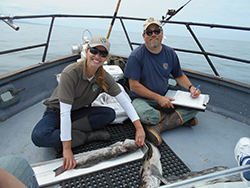 Ed trains a CRFS sampler aboard a CPFV off Fort Bragg
Ed trains a CRFS sampler aboard a CPFV off Fort Bragg
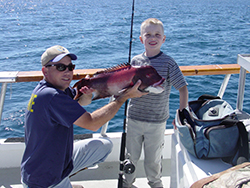
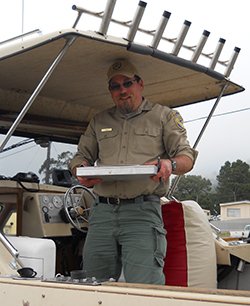 Ed examining catch aboard a boat in Shelter Cove
Ed examining catch aboard a boat in Shelter Cove
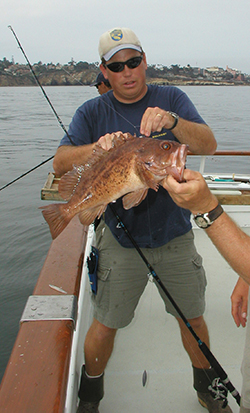 Ed preparing to tag a brown rockfish aboard a CPFV off La Jolla
Ed preparing to tag a brown rockfish aboard a CPFV off La Jolla
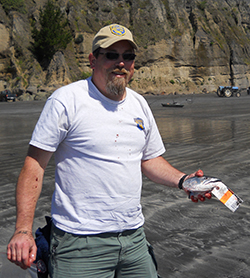 Ed collecting a salmon head in Shelter Cove
Ed collecting a salmon head in Shelter Cove
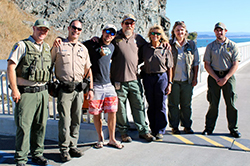 Trinidad Pier Youth Fishing Tournament CDFW Staff
Trinidad Pier Youth Fishing Tournament CDFW Staff
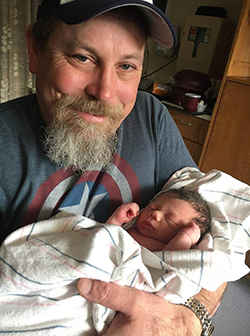 Ed and his new grandson, Edgar V
Ed and his new grandson, Edgar V
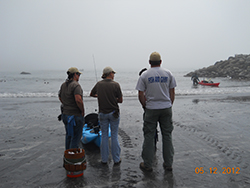 Ed training new CRFS samplers in Shelter Cove
Ed training new CRFS samplers in Shelter Cove
Edgar “Ed” W. Roberts III is an environmental scientist in CDFW’s Eureka office. As the lead for the California Recreational Fisheries Survey (CRFS) in Del Norte, Humboldt and Mendocino counties, Ed is responsible for all aspects of the CRFS on the north coast, from training new staff, to creating sampling schedules, to making sure sampling goals are met.
Ed was born in Oceanside and grew up in San Diego, where he lived until he left for college at Humboldt State University, where he earned a Bachelor of Science in Marine Biology.
Who or what inspired you to become a scientist?
My passion for fishing and stewardship of the environment was instilled in me by my father and grandfather along the streams and lakeshores of the Sierra Nevada. I kept the first fish I caught (a nice CDFG stocked rainbow trout taken at June Lake when I was 5) in my mother’s freezer for years and would break it out for show-and-tell whenever someone new would come to the house. Growing up in San Diego, I spent a lot of time at the ocean, and I read and watched Jacques Cousteau religiously. I had a sense early on in life that I wanted to become a marine fisheries biologist.
During those fishing trips with my father and grandfather, I also met many CDFW game wardens. Through them I learned about CDFW’s mission, which really appealed to me and my outdoor ethics.
How did you come to work for CDFW?
I started my fisheries career working seasonal and part-time jobs, as most CDFW scientists do. I worked on the CRFS’ predecessor, the Marine Recreational Fisheries Statistics Survey, for the Pacific States Marine Fisheries Commission, as well as several CDFW scientific aid positions. Those projects were interesting and included an aerial census of the harbor seal population in California and a bycatch study of the commercial spot prawn fishery.
In 2000, I was hired as a marine biologist to work primarily on outreach and developing youth fishing and educational programs at the Upper Newport Bay Ecological Reserve and Back Bay Science Center. Since then I’ve worked on the implementation of the Marine Life Management Act, the Nearshore Fishery Management Plan, the development and implementation of CRFS, and other work for the Marine Region’s Groundfish and Invertebrate projects.
What is the most rewarding project that you’ve worked on for CDFW?
I represented CDFW on a collaborative groundfish tagging project from 2002 to 2006. At the time, I believe it was the biggest fish tagging program of its kind in the state – we tagged over 32,300 fish from 32 species and learned quite a bit about the life histories and movements of some previously little-studied species. During the early 2000s, the California charter boat industry was hit hard by recently implemented bottomfishing restrictions that were necessary to help depleted fish stocks recover. This tagging study was paid for primarily through federal groundfish disaster relief funds. We hired sportfishing boats that were impacted by these new restrictions to use as research platforms, helping to ease the economic problems their owners and operators were facing. At the same time, we, the fishery biologists, worked side-by-side with the captains, crews and volunteer anglers we enlisted to help us with the work, benefiting from their experience and on-the-water observations. It was a great example of resource managers and consumptive users working together for a common purpose. I am very thankful for the opportunity to have been a part of that project.
Tell us about your current work with the CRFS.
The CRFS is a statewide survey of marine recreational anglers. CRFS samplers intercept saltwater sportfishers at the completion of their fishing trips, ask them some questions about that trip and their fishing habits and collect biological data from their catch. The data we collect are then used to create estimates of saltwater sport catch and effort. Those estimates are used by fishery managers at both the state and federal level to manage our state’s finfish resources for sustainability. If you’re reading this and you’ve ever participated in our survey, I want to thank you for your cooperation, and for doing your part to conserve our resources.
Within the CRFS, my specific and primary responsibility is to ensure that the data we collect is of the highest quality. I work towards fulfilling that responsibility by cultivating and maintaining good working relationships with the angling public to increase awareness of and cooperation with our survey, by working with my staff in the field to make sure our strict sampling protocols are followed, by reviewing the data my staff collect for quality control purposes, and by reviewing the estimates of marine finfish catch and effort that are generated using those data.
CRFS, by design, can be used to document changes in fisheries and species assemblages that may be due to variable oceanic conditions caused by climate change. We observed many unusual occurrences this last year, and I’m currently working to publish some of those findings.
What is the best thing about your job?
Aside from the pride I have in knowing I am working to maintain, enhance and restore our marine ecosystems for the use and enjoyment of present and future Californians, I get a lot of satisfaction from helping students and recent graduates with degrees in natural resources gain valuable experience in their chosen field. Many former employees have expressed their appreciation for the opportunity to hone their skills. Those thanks really mean a lot to me and make me feel like I’m making a difference.
Over the course of your career, was there a discovery or incident that surprised you?
I recently published a note regarding a tag return from a California scorpionfish that I tagged in 2004 (tagged during the same project I mentioned previously). It was recaptured in 2017, after spending almost 14 years at liberty with my tag in its back. Interestingly, the fish was caught in almost the same location where it was originally captured and remains the longest documented tag retention for this species.
Do you have any advice for people considering careers in science or natural resources?
Most of the people I’ve met during my career are not here for the money – they do their jobs because they have a desire to learn and passion for the resource with the end goal being sustainability. Don’t go into the field expecting to get rich. Cultivate your passion for science and resource management during your education, and be prepared to work entry level, seasonal, part-time jobs to make connections and get your foot in the door. Success in this field is equal parts passion and perseverance.
Away from work, where are we likely to find you?
Fishing and camping with my family is the greatest pleasure in my life. On a day off, or even after work, you might find me fishing the south jetty at Humboldt Bay with my wife, children, brother-in-law and nephews. On vacation, you might find me camping and fishing with the same crew, plus some aunts and uncles, at Trinity Lake or on the Kern River.
Tell us something about yourself that many people would be surprised to learn.
I’m an Eagle Scout, volunteered with Scouting for more than 15 years, and I am an Army veteran. I’ve played fantasy baseball with the same group of people for the last 30 years. Also, my grandson, Edgar V, was born on March 16, 2019. I can’t wait to help my son pass on our love for fishing to his son.